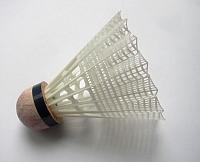Shuttlecock
This article needs additional citations for verification. (August 2012) |


A shuttlecock (also called a bird or birdie) is a high-drag projectile used in the sport of badminton. It has an open conical shape formed by feathers (or a synthetic alternative) embedded into a rounded cork (or rubber) base. The shuttlecock's shape makes it extremely aerodynamically stable. Regardless of initial orientation, it will turn to fly cork first, and remain in the cork-first orientation.
Name
The name 'shuttlecock' originates in 1570s England, when badminton first became popular. It is frequently shortened to shuttle. The "shuttle" part of the name is derived from its back-and-forth motion during the game, resembling the shuttle of a 14th-century loom, while the "cock" part of the name is derived from the resemblance of the feathers to those on a chicken.[1]
Specifications
A shuttlecock weighs around 4.75 to 5.50 g (0.168 to 0.194 oz). It has 16 feathers with each feather 70 mm (2.8 in) in length. The diameter of the cork is 25 to 28 mm (0.98 to 1.10 in) and the diameter of the circle that the feathers make is around 58 to 68 mm (2.3 to 2.7 in).[citation needed]
Construction and materials
A shuttlecock is formed from 16 or so overlapping feathers, usually goose or duck, embedded into a rounded cork base. The cork is covered with thin leather.[2] To ensure satisfactory flight properties, it is considered preferable to use feathers from right or left wings only in each shuttlecock, and not mix feathers from different wings, as the feathers from different wings are shaped differently.[3][4]
Feather or synthetic shuttlecocks
The feathers are brittle; shuttlecocks break easily and often need to be replaced several times during a game. For this reason, synthetic shuttlecocks have been developed that replace the feathers with a plastic skirt. Players often refer to synthetic shuttlecocks as plastics and feathered shuttlecocks as feathers.
Feather shuttles need to be properly humidified for at least 4 hours prior to play in order to fly the correct distance at the proper speed and to last longer. Properly humidified feathers flex during play, enhancing the shuttle's speed change and durability. Dry feathers are brittle and break easily, causing the shuttle to wobble. Saturated feathers are 'mushy', making the feather cone narrow too much when strongly hit, which causes the shuttle to fly overly far and fast. Typically a humidification box is used, or a small moist sponge is inserted in the feather end of the closed shuttle tube container, avoiding any water contact with the cork of the shuttle. Shuttles are tested prior to play to make sure they fly true and at the proper speed, and cover the proper distance. Different weights of shuttles are used to compensate for local atmospheric conditions. Both humidity and height above sea level affect shuttle flight. World Badminton Federation Rules say the shuttle should reach the far doubles service line plus or minus half the width of the tram. According to manufacturers proper shuttle will generally travel from the back line of the court to just short of the long doubles service line on the opposite side of the net, with a full underhand hit from an average player.[5]
The cost of good quality feathers is similar to that of good quality plastics, but plastics are far more durable, typically lasting many matches without any impairment to their flight. Shuttles are easily damaged and should be replaced every three or four games, and sooner if they are damaged and do not fly straight. This interferes with the game, as the impairment on the flight of the shuttle may misdirect the direction of the shuttlecock.
Most experienced and skillful players greatly prefer feathers, and serious tournaments or leagues are always played using feather shuttlecocks of the highest quality.[6]
The playing characteristics of plastics and feathers are substantially different. Plastics fly more slowly on initial impact, but slow down less towards the end of their flight. While feathers tend to drop straight down on a clear shot, plastics never quite return to a straight drop, falling more on a diagonal. Feather shuttles may come off the strings at speeds in excess of 320 km/h (200 mph) but slow down faster as they drop.
See also
- Jianzi: a traditional Asian game in which players aim to keep a heavily weighted shuttlecock (Jian) from touching the ground
- Battledore and shuttlecock: an ancient game similar to that of modern badminton.
- This Time with Alan Partridge: a shuttlecock played a vital part in the second episode.
References
- ^ https://www.etymonline.com/word/cock?ref=etymonline_crossreference#etymonline_v_15751
- ^ "Making Birdies: How Shuttlecocks Are Made". Official Badminton. Official Badminton. Retrieved 24 February 2015.
- ^ "Yonex Shuttle News" (PDF). http://www.yonex.ch/. Yonex. Retrieved July 14, 2017.
{{cite web}}: External link in|website= - ^ Kiley, Brendan (July 24, 2013). "The Rise of the Shuttlecock". The Stranger. Retrieved August 13, 2016.
- ^ Adapted from various Shuttlecock Manufacturer's recommendations - RSL, Yonex, Carleton, among others by J. Wigglesworth. May 2015
- ^ "BWF's tournament sanctioned shuttlecocks". Badminton World Federation site. Retrieved 2011-11-01.
- "shuttlecock: badminton equipment consisting of a ball of cork or rubber with a crown of feathers." Random House Kernerman Webster's College Dictionary, 2010. K Dictionaries Ltd.
External links
 Media related to Shuttlecocks at Wikimedia Commons
Media related to Shuttlecocks at Wikimedia Commons The dictionary definition of shuttlecock at Wiktionary
The dictionary definition of shuttlecock at Wiktionary
